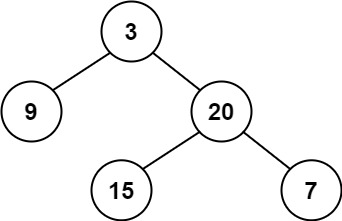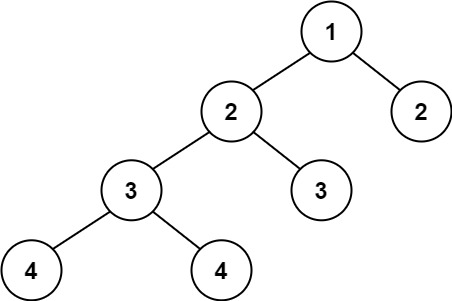演算法筆記-Tree-2
Binary Search Tree
二元搜尋樹有以下特性:
- 一個節點的左子樹只包含鍵值小於該節點的節點。
- 一個節點的右子樹只包含鍵值大於該節點的節點。
- 左子樹和右子樹也都是二分搜尋樹。
而且以中序遍歷二元搜尋樹會得到一個遞增的數列。
操作
搜索
根據待查元素val 與當前 root -> val 的關係判斷:
root -> val == val回傳當前root。root -> val > val查找左子樹。root -> val < val查找右子樹。
1 | TreeNode* searchBST(TreeNode* root, int val) { |
插入
根據待查元素val 與當前 root -> val 的關係判斷:
root == nullptr插入新節點。root -> val > val重新構造左子樹。root -> val < val重新構造右子樹。
1 | TreeNode* insertIntoBST(TreeNode* root, int val) { |
刪除
先用遞迴的方式找到要刪除的節點,並根據其左右子樹的情況做處理:
- 左右子樹皆為空:直接刪除節點,回傳
nullptr。 - 左子樹為空:以右子樹取代該節點,回傳
root -> right。 - 右子樹為空:以左子樹取代該節點,回傳
root -> left。 - 左右子樹皆不為空:把左子樹插入
右子樹最小的節點的左邊,以右子樹取代該節點,回傳root -> right。
1 | TreeNode* deleteNode(TreeNode* root, int key) { |
還原
前序
因為二元搜尋樹的特性,在區分左、右子樹時不需要利用到中序遍歷,只要在前序遍歷中找到鍵值大於根結點的地方就是右子樹。
1 | TreeNode* buildTree(vector<int> preorder, int left, int right) { |
後序
和前序遍歷類似,只是根節點的位置要從最後面找。
中序
因為無法確定根結點所在的位置 (一定為遞增數列),因此無法構造出唯一的樹。
Segment Tree
線段樹是二元平衡樹的一種,用以儲存區間或線段,每個節點代表一個區間,而根結點代表區間的全部範圍,葉節點代表長度為 1 的區間,而編號方式以及代表的區間規則如下:
- 根結點編號為 0,並且代表整個區間的範圍。
- 假設當前節點編號為
i,代表的區間為[left, right],假設mid = (left + right) / 2則:- 左節點編號為
i * 2,代表的區間為[left, mid]。 - 右節點編號為
i * 2 + 1,代表的區間為[mid + 1, right]。
- 左節點編號為
構造
假設有一數組 v,要建構一個線段樹來儲存每個區間的數字和,我們利用 tree 來儲存該線段樹的資料,建構的方式是使用遞迴不斷建立左右子節點,直到長度為 1 的葉節點。
1 | vector<int> tree; |
查詢
查詢的過程依舊是由上而下進行遞迴,根據查詢的區間 [q_left, q_right] 以及結點所儲存的資料區間 [left, mid],來決定回傳的結果,可以分為三種情況:
查詢區間和節點區間沒有交集,則回傳0。查詢區間包含節點區間,則回傳節點的值。查詢區間與節點區間有部分交集,則分別對左右子樹進行查詢,接著將結果進行聚合 (聚合的方式視線段樹的規則而訂)。
1 | int query(int node, int left, int right, int q_left, int q_right){ |
更新
由上而下遞迴進行更新,不斷更新節點儲存的值,並且對子樹也進行更新,直到目標節點時才停止。
1 | void update(int node, int left, int right, int index, int val){ |
Disjoint set & Union-find algorithm
並查集是一種資料結構,用於處理一些不交集的合併及查詢問題,而使用的 Union-find algorithm 主要包含了以下功能:
- 查找 (Find):查詢元素屬於哪個集合。
- 合併 (Union):將兩個集合合併為一個。
使用樹的概念儲存每個集合,樹的根結點就用來代表該集合,而所有樹所形成的森林則是所有的元素。
查找
因為樹的根結點代表該集合,因此在查找的時候只要不斷往回推,直到該節點指向自己 (根節點) 就好。
1 | int Find(int x){ |
合併
合併兩個集合其實就是把兩棵樹接起來,首先要先判斷各自的根結點,如果根結點相同則代表是相同集合,否則則要進行合併,將一個集合的根結點指向另一個集合的根結點即可。
1 | void Union(int a,int b){ |
優化
路徑壓縮
經過路徑壓縮後,可以減少回推根結點時的迭代次數,增加效率,通常在查詢時順便進行壓縮。
1 | int Find(int x){ |
按秩合併
每次進行合併時,把秩比較小的樹根結點指向秩較大的樹根結點,秩主要有兩種定義方式,分別是樹的深度以及元素個數。
練習
LeetCode 110. Balanced Binary Tree
Given a binary tree, determine if it is height-balanced.
Example 1:

Input: root = [3,9,20,null,null,15,7]
Output: true
Example 2:

Input: root = [1,2,2,3,3,null,null,4,4]
Output: false
Example 3:
Input: root = []
Output: true
Solution:
1 | class Solution { |
建立一個 treeHeight 函數,在所在子樹為平衡二元樹時回傳其高度,否則回傳 -1,因此最終只要傳入根結點並判斷其回傳值是否為 -1 就好。
LeetCode 307. Range Sum Query - Mutable
Given an integer array nums, handle multiple queries of the following types:
- Update the value of an element in
nums. - Calculate the sum of the elements of
numsbetween indicesleftandrightinclusive whereleft <= right.
Implement the NumArray class:
NumArray(int[] nums)Initializes the object with the integer arraynums.void update(int index, int val)Updates the value ofnums[index]to beval.int sumRange(int left, int right)Returns the sum of the elements ofnumsbetween indicesleftandrightinclusive (i.e.nums[left] + nums[left + 1] + ... + nums[right]).
Example 1:
Input
[“NumArray”, “sumRange”, “update”, “sumRange”]
[[[1, 3, 5]], [0, 2], [1, 2], [0, 2]]
Output
[null, 9, null, 8]
Solution:
1 | class NumArray { |
利用線段樹的方式儲存各區間的數字和,使用構造、查詢、更新三個函數。
LeetCode 399. Evaluate Division
You are given an array of variable pairs equations and an array of real numbers values, where equations[i] = [Ai, Bi] and values[i] represent the equation Ai / Bi = values[i]. Each Ai or Bi is a string that represents a single variable.
You are also given some queries, where queries[j] = [Cj, Dj] represents the jth query where you must find the answer for Cj / Dj = ?.
Return the answers to all queries. If a single answer cannot be determined, return -1.0.
Note: The input is always valid. You may assume that evaluating the queries will not result in division by zero and that there is no contradiction.
Note: The variables that do not occur in the list of equations are undefined, so the answer cannot be determined for them.
Example 1:
Input: equations = [[“a”,“b”],[“b”,“c”]], values = [2.0,3.0], queries = [[“a”,“c”],[“b”,“a”],[“a”,“e”],[“a”,“a”],[“x”,“x”]]
Output: [6.00000,0.50000,-1.00000,1.00000,-1.00000]
Example 2:
Input: equations = [[“a”,“b”],[“b”,“c”],[“bc”,“cd”]], values = [1.5,2.5,5.0], queries = [[“a”,“c”],[“c”,“b”],[“bc”,“cd”],[“cd”,“bc”]]
Output: [3.75000,0.40000,5.00000,0.20000]
Example 3:
Input: equations = [[“a”,“b”]], values = [0.5], queries = [[“a”,“b”],[“b”,“a”],[“a”,“c”],[“x”,“y”]]
Output: [0.50000,2.00000,-1.00000,-1.00000]
Solution:
1 | class Solution { |
使用並查集以及一個 unordered map 來儲存變數之間的關係以及倍數,FindTimes 函數則是往回推算該變數與其根結點變數之間的倍數關係,在進行查詢時,可以分為幾種情況:
- 查詢變數不在並查集中:回傳
-1。 - 查詢變數不在相同的樹中 (根結點相異):回傳
-1。 - 查詢變數在相同的樹中 (根結點相同):回傳兩變數分別與根節點的倍數關係相除
FindTimes(queries[i][1]) / FindTimes(queries[i][0])。
LeetCode 765. Couples Holding Hands
There are n couples sitting in 2n seats arranged in a row and want to hold hands.
The people and seats are represented by an integer array row where row[i] is the ID of the person sitting in the ith seat. The couples are numbered in order, the first couple being (0, 1), the second couple being (2, 3), and so on with the last couple being (2n - 2, 2n - 1).
Return the minimum number of swaps so that every couple is sitting side by side. A swap consists of choosing any two people, then they stand up and switch seats.
Example 1:
Input: row = [0,2,1,3]
Output: 1
Example 2:
Input: row = [3,2,0,1]
Output: 0
Solution:
1 | class Solution { |





